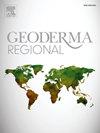Using near-infrared spectroscopy as a cost-effective method to characterise soil and leaf properties in native forest
IF 3.3
2区 农林科学
Q2 SOIL SCIENCE
引用次数: 0
Abstract
Forests conservation and sustainable management of forests require an understanding of ecological traits that influence carbon and nutrient turnover in forest ecosystems. This study evaluates the potential of Near Infrared Spectroscopy (NIRS) as a rapid, non-destructive and cost-effective tool for characterising soil and trees in natural forests and forest-frontier ecosystems. Soil samples were collected at four depths from three land uses (native forest, grazed grassland, and horticultural land), while leaf samples were obtained from two provenances of Nothofagus alpina. Spectra were used to classify samples, predict biological and chemical properties, estimate relatedness matrices for both soils and leaves and compared them with those obtained from genetic data. Principal component analysis separated soil samples from different land uses and depths as well as leaf samples from the two provenances. NIRS-based models showed high predictive accuracy for soil microbial biomass, biological activity and total carbon (R2 = 0.80, 0.94, and 0.86, respectively), although leaf pigment estimation was less reliable (R2 = 0.60–0.40). Correlations between genetic and NIRS relatedness matrices were low, highlighting that both methodologies are relevant for sample characterisation. These findings demonstrate that NIRS is a useful method for assessing soil ecological traits associated with nutrient cycling offering a practical and cost-efficient alternative for ecological monitoring in forest ecosystems. However, further methodological improvements are needed to enhance its accuracy, particularly for leaf traits characterisation. This study highlights the broader potential of NIRS for large-scale forest management, conservation strategies, and ecological research.
利用近红外光谱作为一种具有成本效益的方法来表征原始森林中土壤和树叶的特性
森林保护和森林可持续管理需要了解影响森林生态系统中碳和养分周转的生态特性。本研究评估了近红外光谱(NIRS)作为表征天然林和森林边界生态系统中土壤和树木的快速、非破坏性和成本效益工具的潜力。土壤样本采集于3种土地利用方式(原生林、放牧草地和园艺地)的4个深度,叶片样本采集于2个种源的Nothofagus alpina。光谱用于分类样品,预测生物和化学性质,估计土壤和叶片的相关性矩阵,并将其与遗传数据进行比较。主成分分析分离了不同土地利用方式和深度的土壤样品以及两个种源的叶片样品。基于nir的模型对土壤微生物生物量、生物活性和总碳的预测精度较高(R2分别为0.80、0.94和0.86),但对叶片色素的预测可靠性较低(R2 = 0.60-0.40)。遗传和近红外相关性矩阵之间的相关性很低,突出表明这两种方法都与样本表征相关。这些研究结果表明,近红外光谱是评估与养分循环相关的土壤生态性状的有效方法,为森林生态系统的生态监测提供了一种实用且经济有效的替代方法。然而,进一步的方法改进需要提高其准确性,特别是叶片性状表征。这项研究强调了近红外光谱在大规模森林管理、保护策略和生态研究方面的更广泛潜力。
本文章由计算机程序翻译,如有差异,请以英文原文为准。
求助全文
约1分钟内获得全文
求助全文
来源期刊

Geoderma Regional
Agricultural and Biological Sciences-Soil Science
CiteScore
6.10
自引率
7.30%
发文量
122
审稿时长
76 days
期刊介绍:
Global issues require studies and solutions on national and regional levels. Geoderma Regional focuses on studies that increase understanding and advance our scientific knowledge of soils in all regions of the world. The journal embraces every aspect of soil science and welcomes reviews of regional progress.
 求助内容:
求助内容: 应助结果提醒方式:
应助结果提醒方式:


